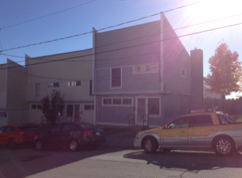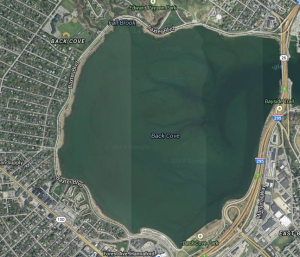In my walk through Portland, I was most struck by stark juxtapositions within the city in regards to standards of living. I noticed the construction of condos and apartments near blocks and blocks of identical low-income housing. I noticed the existence of a Planet Dog – a store exclusively for the accessories, beds, toys, and food receptacles of Portland’s canines – next to homeless people begging with signs on the street. I noticed the irony of an upscale antique store and a home entertainment store just down the road from the Preble Street Resource Center and Salvation Army.
These observations highlighted what I believe to be Portland’s (and many other cities’) central tension between the rise of the city as a popular, ‘hip’ tourist destination and the prevailing difficulty of life for the city’s lower class, ‘at-risk’ population. This tension manifested itself toward the end of my transect walk in Congress Square Park. With an interest sparked by our guided tour and conversation with Caitlin Cameron, I took a brief walk around the park and took a couple pictures. I walked up the steps to leave and was followed by a woman for several blocks, slurring and screaming obscenities at me such as “Fuck the White House, bitch.” Upon reflection, this exchange was representative of this central tension – an ostensibly well-to-do white girl wielding a large SLR camera, entering a space of day-to-day struggle for local citizens, which for me is just a space of temporary and lighthearted exploration. Going forward, I will continue to reflect upon and consider these juxtapositions and tensions.
Transect Walk
Congress Street
-Development of 118 on Munjoy Hill, “new boutique condo” deemed controversial by the Bangor Daily News. The developers are recording the construction process and advertising time-lapse videos on the web: http://118onmunjoyhill.com/time-lapse/
(43.66594, -70.247428)

Kellogg Street
-Homogeneous housing…potentially public housing? Public ordinance sign: “No drinking of alcoholic beverages”

Washington Avenue
-More racial and linguistic diversity than I’ve seen yet, compared to Congress Street in particular
-Prominent police presence
Montgomery Street
-Two adult black males, staggering and slurring their words, bounce a basketball with a boy approximately 10 years old, while firemen break into a home a few houses down
Anderson Street
-Cars on the street significantly nicer than the houses
-Racial diversity
-Same homogenous housing from Kellogg Street
Franklin Street
-Homeless people hold up signs at a busy intersection, adjacent to Planet Dog
Intersection: (43.665364, -70.260148) Planet Dog: (43.664990, -70.260019)

Back Cove Park
-Environmental concerns with rising sea level
-Development of apartments: (43.6630577, -70.2639535)
Google Images
Preble Street
-Skillful Home Recreation: (43.660955, -70.263761) & Portland Architectural Salvage (antique store): (43.660684, -70.263517) on the same street as Preble Street Resource Center: (43.6587404, -70.2618871) and Salvation Army: (43.659377, -70.2625879) – ironic juxtaposition
Congress Square Park

-Interaction with the lady who followed me: (43.6542343, -70.2632788)



I also noticed similar juxtapositions, particularly during my interactions while collecting mental maps. My transect walk was more homogeneous than yours, but that was because I was in a primarily gentrified, upscale neighborhood. I noticed several blocks of homogeneous housing as well in Munjoy Hill, although I doubt that it was low-income housing. I wonder if there are often socioeconomic clashes as the one you experienced or if the woman was following you because it was more obvious that you were an “ostensibly well-to-do white girl.”
The construction of 118 on Munjoy Hill caught my eye as well. It immediately presents itself as a part of the neighborhood, as fitting in seamlessly. But it looks so gaudy, so out of place! I wonder what apartments will cost…
I think your transect walk gets at a hard reality of city life; namely, that wealth creates a lot of what we so love about cities, or a lot of what we love is predicated upon being able to afford it. It’s something I had a problem with when reading “City Life and Difference”–not all differences are embraced or given equal weight. Portland’s homeless population is both most visible and invisible–this is the problem you get at with your transect.
I really like how you incorporate people into your transect walk, rather than just focus on the buildings. The constant interactions between socioeconomic class, housing, drugs, and the police/fire departments is demonstrated by your observations. It’s clear that the gentrification or “improvement” of Portland is only beneficial to certain sectors of society, resulting in not only the displacement but also the vilification of the others. It’s tough to figure out how public policy can help tackle this problem.
I saw a lot of these same tensions manifested in East Bayside, where traditionally ‘at-risk’ groups seem to have established a foothold in the past few decades. With the encroachment of well-to-do young people and their luxury condos, the proximity creates a dissonance in every block. Similar to your planet dog observation, it seems that Whole Foods is strangely close to the largest low-income housing development I encountered in Bayside, and I’m sure the residential population across the street sees the upscale market as a high-flying flag of gentrification not built for them. I am curious to hear what can be done to create retail spaces that bridge the gap between upscale antiques and Salvation Army, or if certain areas of Portland will always be off-limits for the low-income population due to business interests.